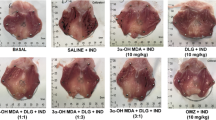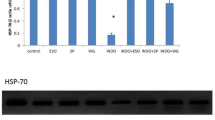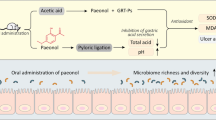Abstract
Proton pump inhibitors exert their preventive and healing effects on gastropathy induced by nonsteroidal anti-inflammatory drug (NSAIDs) by a dual action: the antisecretory and the antioxidant effect. The latter was investigated by using esomeprazole against indomethacin-induced gastric mucosa lesions in rats and assessed by a histomorphometric analysis. Treatment by intragastric gavage were 1% methocel as vehicle; esomeprazole 10, 30, or 60 µmol/kg; indomethacin 100 µmol/kg; and esomeprazole 10, 30, or 60 µmol/kg plus indomethacin 100 µmol/kg. The evaluation of glutathione (GSH) levels and respiratory chain complex activities [nicotinamide adenine dinucleotide, reduced (NADH)-ubiquinone oxidoreductase, succinate dehydrogenase, cytochrome C reductase, cytochrome oxidase] was performed in the isolated gastric mucosa. Esomeprazole (10–60 µmol/kg) dose dependently reversed, up to complete recovery, the inhibitory effect of indomethacin on GSH levels (approximately 60% inhibition) and mitochondrial enzyme activities (inhibition ranging from 60% to 75%). Indomethacin-induced mucosal injuries were reduced by esomeprazole. Thus, in addition to inhibiting acid secretion, the gastroprotective effect of esomeprazole can be ascribed to a reduction in gastric oxidative injury.




Similar content being viewed by others
References
Agastya G, West BC, Callahan JM (2000) Omeprazole inhibits phagocytosis and acidification of phagolysosomes of normal human neutrophils in vitro. Immunopharmacol Immunotoxicol 22:357–372
Anderson ME (1985) Determination of glutathione and glutathione disulfide in biological samples. Methods Enzymol 113:548–555
Banerjee D, Maity B, Bauri AK, Bandyopadhyay SK, Chattopadhyay S (2007) Gastroprotective properties of Myristica malabarica against indomethacin-induced stomach ulceration: a mechanistic exploration. J Pharm Pharmacol 59:1555–1565
Biswas K, Bandyopadhyay U, Chattopadhyay I, Varadaraj A, Ali E, Banerjee RK (2003) A novel antioxidant and antiapoptotic role of omeprazole to block gastric ulcer through scavenging of hydroxyl radical. J Biol Chem 278:10993–11001
Blandizzi C, Natale G, Gherardi G, Lazzeri G, Marveggio MC, Colucci R, Carignani D, Del Tacca M (1999) Acid-independent gastroprotective effects of lansoprazole in experimental mucosal injury. Dig Dis Sci 44:2039–2050
Blandizzi C, Fornai M, Colucci R, Natale G, Lubrano V, Vassalle C, Antonioli L, Lazzeri G, Del Tacca M (2005) Lansoprazole prevents experimental gastric injury induced by non-steroidal anti-inflammatory drugs through a reduction of mucosal oxidative damage. World J Gastroenterol 11:4052–4060
Fernandez-Checa JC, Kaplowitz N, Garcia-Ruiz C, Colell A, Miranda M, Marì M, Ardite E, Morales A (1997) GSH transport in mitochondria: defense against TNF-induced oxidative stress and alcohol-induced defect. Am J Physiol 273:G7–G17
Fornai M, Natale G, Colucci R, Tuccori M, Carazzina G, Antonioli L, Baldi S, Lubrano V, Abramo A, Blandizzi C, Del Tacca M (2005) Mechanisms of protection by pantoprazole against NSAID-induced gastric mucosal damage. Naunyn-Schmiedeberg’s Arch Pharmacol 372:79–87
Hassan A, Martin E, Puig-Parellada P (1998) Role of antioxidants in gastric mucosal damage induced by indomethacin in rats. Methods Find Exp Clin Pharmacol 20:849–854
Hiraishi H, Shimada T, Terano A (2000) Involvement of oxidative stress in the pathogenesis of NSAID-induced gastric mucosal damage. J Gastroenterol 35:567–569
Jacob M, Bjarnason I, Simpson RJ (2001) Effects of indomethacin on energy metabolism in rat and human jejunal tissue in vitro. Clin Sci 101:493–498
Janssen M, Dijkmans BAC, Vandenbroucke JP, Biemond I, Lamers CB (1994) Achlorhydria does not protect against benign upper gastrointestinal ulcers during NSAID use. Dig Dis Sci 39:362–365
Koch TR, Petro A, Darrabie M, Opara EC (2004) Effect of the H, K-ATPase inhibitor, esomeprazole magnesium, on gut total antioxidant capacity in mice. J Nutr Biochem 15:522–526
Koch TR, Petro A, Darrabie M, Opara EC (2005) Effects of esomeprazole magnesium on nonsteroidal anti-inflammatory drug gastropathy. Dig Dis Sci 50:86–93
Kwiecien S, Brzozowski T, Konturek SJ (2002) Effects of reactive oxygen species action on gastric mucosa in various models of mucosal injury. J Physiol Pharmacol 53:39–50
Laneuville O, Breuer DK, Dewitt DL, Hla T, Funk CD, Smith WL (1994) Differential inhibition of human prostaglandin endoperoxidase H synthases-1 and -2 by nonsteroidal anti-inflammatory drugs. J Pharmacol Exp Ther 271:927–934
Lapenna D, De Gioia S, Cofani G, Festi D, Cuccurullo F (1996) Antioxidant properties of omeprazole. FEBS Lett 382:189–192
Loguercio C, Di Pierro M (1999) The role of glutathione in the gastrointestinal tract: a review. Ital J Gastroenterol Hepatol 31:401–407
Lowry OH, Rosebrough MJ, Farr AL, Randall RJ (1951) Protein measurement with the Folin phenol reagent. J Biol Chem 193:265–275
Mahmud T, Rafi SS, Scott DL, Wrigglesworth JM, Bjarnason I (1996) Non-steroidal anti-inflammatory drugs and uncoupling of mitochondrial oxidative phosphorylation. Arthritis Rheum 39:1998–2003
Martensson J, Lai JCK, Meister A (1990) High-affinity transport of glutathione is part of a multicomponent system essential for mitochondrial function. Proc Natl Acad Sci USA 87:7185–7189
Martins de Oliveira R, Antunes E, Pedrazzoli J Jr, Gambero A (2007) The inhibitory effects of H+K+ ATPase inhibitors on human neutrophils in vitro: restoration by a K+ ionophore. Inflamm Res 56:105–111
Meister A (1983) Functions of glutathione. In: Larrson A, Orrenius S, Halmgren A, Mannervick B (eds) Functions of glutathione: biochemical, physiological, toxicological and clinical aspects. Raven Press, New York, pp 457–472
Meister A (1991) Glutathione deficiency produced by inhibition of its synthesis, and its reversal; applications in research and therapy. Pharmacol Ther 51:155–194
Naesdal J, Brown K (2006) NSAID-associated adverse effects and acid control aids to prevent them. Drug Saf 29:119–132
Natale G, Lazzeri G, Blandizzi C, Gherardi G, Lenzi P, Pellegrini A, Del Tacca M (2001) Seriate histomorphometry of whole rat stomach: an accurate and reliable method for quantitative analysis of mucosal damage. Toxicol Appl Pharmacol 174:17–26
Natale G, Lazzeri G, Lubrano V, Colucci R, Vassalle C, Fornai M, Blandizzi C, Del Tacca M (2004) Mechanisms of gastroprotection by lansoprazole pretreatment against experimentally induced injury in rats: role of mucosal oxidative damage and sulfhydryl compounds. Toxicol Appl Pharmacol 195:62–72
Pastoris O, Dossena M, Vercesi L, Bruseghini M, Pagnin A, Ceriana P (1991) Biochemical changes induced in the myocardial cell during cardioplegic arrest supplemented with creatine phosphate. J Cardiothorac Vasc Anesth 5:475–480
Richardson P, Hawkey CJ, Stack WA (1998) Proton pump inhibitors. Pharmacology and rationale for use in gastrointestinal disorders. Drugs 56:307–335
Robert A, Eberle D, Kaplowitz N (1987) Role of glutathione in gastric mucosal cytoprotection. J Clin Gastroenterol 9:8–13
Sachs G, Shin JM, Briving C, Wallmark B, Hersey S (1995) The pharmacology of the gastric acid pump: the H+,K+ ATPase. Annu Rev Pharmacol Toxicol 35:277–305
Savoye G, Miralles-Barrachina O, Déchelotte P, Belmonte-Zalar L, Brung-Lefebvre M, Zalar A, Hochain P, Hervé S, Colin R, Lerebours E, Ducrotté P (2001) Low levels of gastric mucosal glutathione during upper gastric bleeding associated with the use of nonsteroidal anti-inflammatory drugs. Eur J Gastroenterol Hepatol 13:1309–1313
Simon WA, Sturm E, Hartmann HJ, Weser U (2006) Hydroxyl radical scavenging reactivity of proton pump inhibitors. Biochem Pharmacol 71:1337–1341
Somasundaram S, Rafi S, Hayllar J, Sigthorsson G, Jacob M, Price AB, Macpherson A, Mahmod T, Scott D, Wrigglesworth JM, Bjarnason I (1997) Mitochondrial damage: a possible mechanism of the “topical” phase of NSAID induced injury to the rat intestine. Gut 41:344–353
Somasundaram S, Sigthorsson G, Simpson RJ, Watts J, Jacob M, Tavares IA, Rafi S, Roseth A, Foster R, Price AB, Wrigglesworth JM, Bjarnason I (2000) Uncoupling of intestinal mitochondrial oxidative phosphorylation and inhibition of cyclooxygenase are required for the development of NSAID-enteropathy in the rat. Aliment Pharmacol Ther 14:639–650
Suzuki M, Nakamura M, Mori M, Miura S, Tsuchiya M, Ishii H (1995) Lansoprazole inhibits oxygen-derived free radical production from neutrophils activated by Helicobacter pylori. J Clin Gastroenterol 20:S93–S96
Suzuki M, Mori M, Fukumura D, Suzuki H, Miura S, Ishii H (1999) Omeprazole attenuates neutrophil-endothelial cell adhesive interaction induced by extracts of Helicobacter pylori. J Gastroenterol Hepatol 14:27–31
Takeuchi K, Mizoguchi H, Araki H, Komoike Y, Suzuki K (2001) Lack of gastric toxicity of nitric oxide-releasing indomethacin, NCX-530, in experimental animals. Dig Dis Sci 46:1805–1818
Tsuji S, Sun WH, Tsuji M, Kawai N, Kimura A, Kakiuchi Y, Yasumaru S, Komori M, Murata H, Sasaki Y, Kawano S, Hori M (2002) Lansoprazole induces mucosal protection through gastrin receptor-dependent up-regulation of cyclooxygenase-2 in rats. J Pharmacol Exp Ther 303:1301–1308
Wallace JL (2001) Pathogenesis of NSAID-induced gastroduodenal mucosal injury. Best Pract Res Clin Gastroenterol 15:691–703
Wallace JL, McKnight W, Reuter BK, Vergnolle N (2000) NSAID-induced gastric damage in rats: requirement for inhibition of both cyclooxygenase 1 and 2. Gastroenterology 119:706–714
Wandall JH (1992) Effects of omeprazole on neutrophil chemotaxis, superoxide production, degranulation, and translocation of cytochrome b-245. Gut 33:617–621
Whittle BJ (2003) Gastrointestinal effects of non-steroidal anti-inflammatory drugs. Fundam Clin Pharmacol 17:301–313
Yoshikawa T, Naito Y, Kishi A, Tomii T, Kaneko T, Iinuma S, Ichikawa H, Yasuda M, Takahashi S, Kondo M (1993) Role of active oxygen, lipid peroxidation, and antioxidants in the pathogenesis of gastric mucosal injury induced by indomethacin in rats. Gut 34:732–737
Zedtwitz-Liebenstein K, Wenisch C, Patruta S, Parschalk B, Daxbock F, Graninger W (2002) Omeprazole treatment diminishes intra- and extracellular neutrophil reactive oxygen production and bactericidal activity. Crit Care Med 30:1118–1122
Acknowledgments
We thank Dr. Elena Pigoli for reading the manuscript and for her helpful comments. This study was funded in full by a research grant from AstraZeneca.
Conflict of interest
The authors state there is no conflict of interest.
Author information
Authors and Affiliations
Corresponding author
Rights and permissions
About this article
Cite this article
Pastoris, O., Verri, M., Boschi, F. et al. Effects of esomeprazole on glutathione levels and mitochondrial oxidative phosphorylation in the gastric mucosa of rats treated with indomethacin. Naunyn-Schmied Arch Pharmacol 378, 421–429 (2008). https://doi.org/10.1007/s00210-008-0314-7
Received:
Accepted:
Published:
Issue Date:
DOI: https://doi.org/10.1007/s00210-008-0314-7




